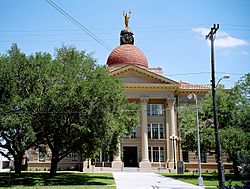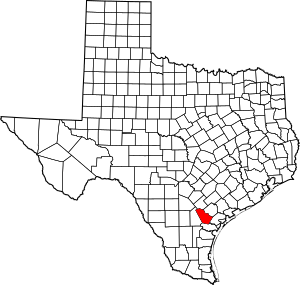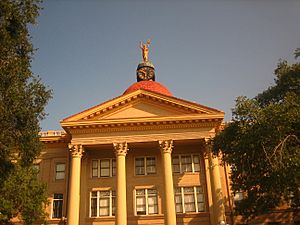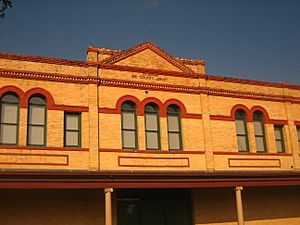Bee County, Texas facts for kids
Quick facts for kids
Bee County
|
|
|---|---|

The Bee County Courthouse in Beeville was built in 1913.
|
|

Location within the U.S. state of Texas
|
|
 Texas's location within the U.S. |
|
| Country | |
| State | |
| Founded | 1858 |
| Named for | Barnard E. Bee, Sr. |
| Seat | Beeville |
| Largest city | Beeville |
| Area | |
| • Total | 880 sq mi (2,300 km2) |
| • Land | 880 sq mi (2,300 km2) |
| • Water | 0.1 sq mi (0.3 km2) 0.01%% |
| Population
(2020)
|
|
| • Total | 31,047 |
| • Density | 35.3/sq mi (13.6/km2) |
| Time zone | UTC−6 (Central) |
| • Summer (DST) | UTC−5 (CDT) |
| Congressional district | 27th |
Bee County is a county in Texas, a state in the United States. It's located in a part of Texas called South Texas. The main town, or county seat, is Beeville. In 2020, about 31,047 people lived here. Bee County was started on December 8, 1857. It's named after Barnard E. Bee, Sr., who was an important leader in the early days of the Republic of Texas.
Contents
History of Bee County
On December 8, 1857, the government of Texas created Bee County. It was made from parts of other counties like Refugio, Live Oak, San Patricio, Goliad, and Karnes. The county was named after Colonel Barnard Elliot Bee. He was a key person in the Republic of Texas, serving as a secretary for leaders like Sam Houston and Mirabeau B. Lamar.
The first settlers in this area during the 1830s were mostly Irish immigrants. Later, in the 1840s and 1850s, more people moved here. These new settlers were mainly from Southern states like North Carolina, South Carolina, Louisiana, and Mississippi. They came to build new homes and communities.
Geography of Bee County
Bee County covers about 880 square miles. Most of this area is land, with only a tiny bit (0.01%) covered by water. The Aransas River starts in Bee County, southwest of Beeville and north of Skidmore.
Main Roads in Bee County
These are the major highways that go through Bee County:
 U.S. Highway 59
U.S. Highway 59
 U.S. Highway 181
U.S. Highway 181 State Highway 72
State Highway 72 State Highway 202
State Highway 202 State Highway 359
State Highway 359 Farm to Market Road 673
Farm to Market Road 673 Farm to Market Road 799
Farm to Market Road 799 Farm to Market Road 888
Farm to Market Road 888
Neighboring Counties
Bee County shares borders with these other counties:
- Karnes County (to the north)
- Goliad County (to the northeast)
- Refugio County (to the east)
- San Patricio County (to the southeast)
- Live Oak County (to the west)
Population of Bee County
| Historical population | |||
|---|---|---|---|
| Census | Pop. | %± | |
| 1860 | 910 | — | |
| 1870 | 1,082 | 18.9% | |
| 1880 | 2,298 | 112.4% | |
| 1890 | 3,720 | 61.9% | |
| 1900 | 7,720 | 107.5% | |
| 1910 | 12,090 | 56.6% | |
| 1920 | 12,137 | 0.4% | |
| 1930 | 15,721 | 29.5% | |
| 1940 | 16,481 | 4.8% | |
| 1950 | 18,174 | 10.3% | |
| 1960 | 23,755 | 30.7% | |
| 1970 | 22,737 | −4.3% | |
| 1980 | 26,030 | 14.5% | |
| 1990 | 25,135 | −3.4% | |
| 2000 | 32,359 | 28.7% | |
| 2010 | 31,861 | −1.5% | |
| 2020 | 31,047 | −2.6% | |
| U.S. Decennial Census 1850–2010 2010–2020 |
|||
In 2020, 31,047 people lived in Bee County. In 2010, about 78.8% of the people were White, 8.1% were Black or African American, and 0.6% were Asian. About 56.2% of the people were of Hispanic or Latino background.
In 2000, there were 9,061 households in the county. About 37.8% of these households had children under 18 living with them. The average household had 2.74 people. The median age in the county was 32 years old.
Education in Bee County
Several school districts serve the students of Bee County:
- Beeville Independent School District
- Mathis Independent School District (partially)
- Pawnee Independent School District (partially, for grades K-8)
- Pettus Independent School District (partially)
- Refugio Independent School District (partially)
- Skidmore-Tynan Independent School District (partially)
- Three Rivers Independent School District (partially)
Coastal Bend College (which used to be called Bee County College) is a college that serves Bee County and other nearby areas.
Communities in Bee County

City
- Beeville (This is the main town and county seat.)
Census-Designated Places
These are areas that are like towns but are not officially incorporated as cities:
Unincorporated Communities
These are smaller communities that are not officially part of a city or census-designated place:
- Blanconia
- Cadiz
- Caesar
- Clareville
- Mineral
- Monteola
- Oaks
- Olmos
- Orangedale
- Papalote
- Yougeen
See also
 In Spanish: Condado de Bee para niños
In Spanish: Condado de Bee para niños


